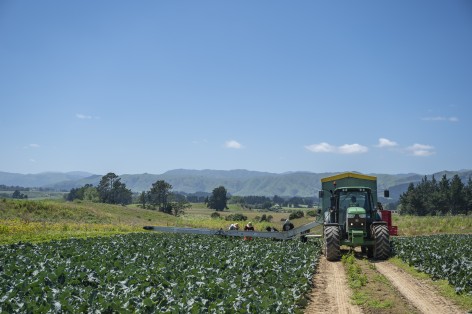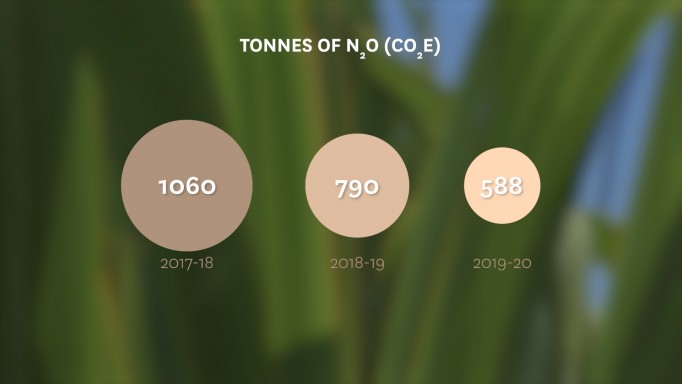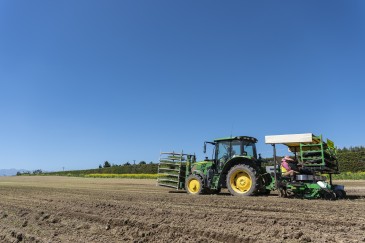Jay Clarke, Horowhenua
Growing fruit and vegetables contributes to New Zealand's agricultural greenhouse gas emissions just as livestock farming does. At Woodhaven Gardens near Levin, Jay Clarke and his family have been figuring out how to reduce their impact on the climate.
About the farm
Woodhaven Gardens was established by the Clarke family in 1978 on the fertile plains of the Horowhenua region. The farm now grows 24 different vegetable crops across more than 1,800 hectares. It employs around 250 staff and, annually, the business sells 27 million individual vegetable units - about 10% of the national supply.
"Vegetable growing is a complex undertaking, whether you're doing it for one crop or 24," says Jay, son of Woodhaven's founders John and Honora Clarke. "Our business isn't one single farm; it's spread out over 127 paddocks with 50 kilometres between the most northern and southern properties. In order to understand our environmental impact, we've had to get to know all those paddocks individually."
Getting to grips with greenhouse gas emissions
Like many vegetable growers, the Clarke family didn't know anything about agricultural greenhouse gas emissions when they started out, but achieving good outcomes for their business, the community and the environment was always front and centre.

Broccoli picking at Woodhaven Gardens (Photo: Dave Allen Photography)
Their journey to understanding their emissions began when they were looking at ways to reduce nutrient leaching. They were approached by scientists at Massey University who helped them understand the impact of nitrogen fertiliser not only on freshwater, but also on the climate.
Nitrous oxide is a potent and long-lived greenhouse gas that comes from a range of sources, including farming. In agriculture, it is emitted into the atmosphere when micro-organisms in the soil act on nitrogen introduced either by animal urine or dung, legume plants or nitrogen-based fertilisers. Methane is another powerful greenhouse gas emitted from farming livestock. But for most horticulture growers, the focus is on nitrous oxide emissions from nitrogen fertiliser use.
"Figuring that out was actually really helpful for us because it meant we were getting a two-pronged approach," says Jay. "We were already looking at nitrogen for freshwater quality. By tackling that, we've also been able to lower our greenhouse gas emissions."
For horticulture producers like the Clarkes, greenhouse gas emissions are directly linked to nitrogen fertiliser use. A small amount of carbon dioxide is also emitted from lime or dolomite use. Horticulture New Zealand and MPI have developed a simple Excel spreadsheet that calculates the emissions from a horticultural operation. You can find out more on our Knowing your numbers page.
The Clarkes' greenhouse gas numbers
In 2019/20, Woodhaven Gardens emitted 588 tonnes of nitrous oxide, expressed as 'carbon dioxide-equivalent' - just under half what they emitted two years prior, and the equivalent of taking over 300 cars off the road.
(Carbon dioxide equivalent describes the amount of carbon dioxide emissions that would provide the same warming effect over a specified period of time as the gas in question, in this case nitrous oxide).

Nitrous oxide emissions from Woodhaven Gardens, 2017-2020
On-farm actions
The team at Woodhaven Gardens works hard to produce the most amount of food for the least amount of fertiliser. Here are the main things they've been doing to manage their nitrogen use:

Planting leeks at Woodhaven (Photo: Dave Allen Photography)
- Developed expertise in the crops they grow - understanding each one's growth cycle and fertiliser requirements.
- Regular soil testing (via a Nitrate Quick test) to find out how much nitrogen is already in the root zone.
- Investment in precision agriculture systems to ensure fertiliser is applied exactly where it is needed and tight to the root zone, at the right rate and the right time.
"We GPS'ed our tractors so we know that our inputs go exactly where we want them to, and we don't get fertiliser in the parts of the farm that don't need it," says Jay.
The Clarkes also pay attention to the health of their soil, using crop rotation and cover crops to further minimise the need for fertiliser.
"I never thought we'd get as far as this," says Jay. "But by changing a whole lot of little things, and being willing to try different things, we've been able to add it all up and have a major impact. It's something we're really proud of."
Jay says they are continuing to learn as they go and there are still parts of the system that need work, including monitoring whether the new, lower levels of fertiliser are sustainable across all seasons in the longer term.
For more on the impact of reducing nitrogen fertiliser, see our Current actions page.
Know your numbers and have a plan
By now, all farmers and growers must have a record of their annual on-farm greenhouse gas emissions (methane and nitrous oxide). By the end of 2024, they'll also need to have a written plan in place to manage them. These requirements are part of the He Waka Eke Noa partnership and are intended to help get farmers ready for agricultural greenhouse gas emissions to be priced from 2025. To find out more on how to do this, see our Know Your Numbers page.

